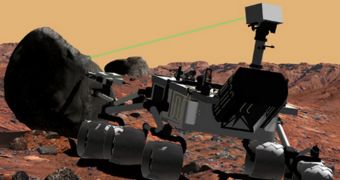The future NASA rover on the Red Planet, the Mars Science Laboratory (MSL), is undoubtedly one of the most complex exploration robots ever devised. It features a host of scientific instruments that can look for signs of life on Mars and even analyze rock samples for traces of former organisms. However, the mission was until now plagued by delays, technical issues and cost overruns, and its fate seemed bleak at one point. Now, the issues are beginning to clear, but one thing still remains in doubt.
Engineers working on the $2.3-billion mission say that the titanium components that have been especially created for the machine may not be up to the tasks planned for them. In other words, it may be that they are simply too weak to endure in Martian conditions. The concerns stem from the fact that the company that supplied the 700 parts in question falsified documents stating that the titanium had been treated to military-grade. At this point, there is no way of knowing if that is true or false.
Recently, it was announced that more than 900 parts were identified in the MSL, but that about 450 of them had already been cleared, and labeled as the “right stuff.” Engineers at the NASA Jet Propulsion Laboratory (JPL) will have to put the MSL, now named Curiosity, through another readiness review after the investigation is over. This is not scheduled to happen very soon, as the paper trail of the titanium parts is very long and complicated, and untangling it is a very laborious process.
On the bright side of things, everything else appears to be running smoothly with the rover. All components that are not made of titanium are beginning to take shape at JPL and other contractors, and there is no major obstacle standing in the way of the planned launch date of September 15, 2011. “MSL is really stabilizing both technically and budgetarily,” the Director of the NASA Mars Exploration Program (MER), Doug McCuistion, says. The nuclear-powered robot, originally scheduled to be launched this year, was delayed countless times due to technical difficulties and lack of funding.
“At this point, I know JPL engineers are working hard to complete construction and I have all fingers and toes crossed that MSL launches on time and lands successfully. Obviously, a major lesson from MSL for all planetary missions is to work hard to improve the fidelity of budget estimates,” University of Colorado in Boulder (UCB) Professor of Astrophysical and Planetary Sciences Fran Bagenal says. The expert is also the Acting Chair of the NASA Advisory Council's Planetary Science Subcommittee.
“We have put potential Outer Planet Flagship (OPF) missions through two cycles of science, technical, management and cost reviews. So, I believe the current estimates of the cost of the Jupiter Europa Orbiter mission are at much better fidelity than MSL at the same stage,” she concludes, quoted by Space.

 14 DAY TRIAL //
14 DAY TRIAL //